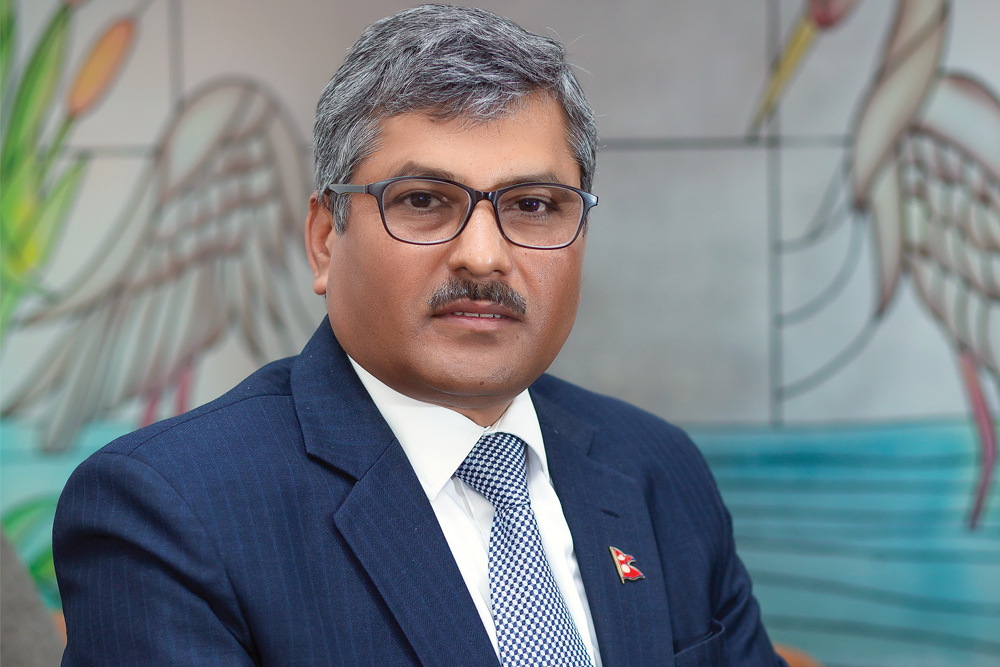
Maha Prasad Adhikari
Governor, Nepal Rastra Bank
Appointed during the time of the Covid 19 crisis on April 6, 2020, Nepal Rastra Bank Governor, Maha Prasad Adhikari has been working to navigate the economy to a safe zone through multiple approaches that include tax relaxation during the pandemic and now minimising the strains on external sector stability. Governor Adhikari has a three-decade-long experience of serving in NRB — the central regulatory and monetary authority — in various positions before he was appointed governor. The central bank provided flexible moratorium to borrowers along with refinancing, subsidised credit and business continuity credit to save enterprises during a turbulent phase of the economy hit by the Covid 19 crisis. As skyrocketing imports put a dent in the Balance of Payments (BoP) situation and hit foreign exchange reserves, the central bank enforced cent percent cash margin provision to open L/Cs (letters of credit) and increased the risk weightage of credit that goes on import financing in a bid to minimise rampant imports. There has been a break in remittance fuelled imports along with new provisions enforced by the central bank and the curve of the sharply depleted foreign exchange reserves in the first half has flattened in the second half of this fiscal. The governor has previously proven himself by enforcing corrective policy measures to drive the financial sector towards the right track during his tenure as deputy governor and is credited for financial stability by executing various supervisory requirements for banks and financial institutions (BFIs), which were on the verge of collapse along with the rise of non-performing assets and exposure to risky sectors triggering shocks in the economy. Adhikari has effectively enforced supervisory and regulatory measures like limiting exposure to real estate and taking prompt corrective action on BFIs. He has also played a crucial role to curb the practice of borrowing from foreign companies/firms at high rates and repatriate dividends in foreign currency to park the funds in tax havens. Adhikari is the main architect behind paid-up capital increment of BFIs by up to four-folds. A regulator turned investment facilitator while working as CEO of Investment Board Nepal, Adhikari has a blended experience in regulation and facilitation.
In an interview with Business 360, Governor Adhikari said Nepal along with other economies worldwide is facing multiple challenges in the post-Covid scenario. He explains the challenges and the rationale behind the Central Bank’s moves. Excerpts:
It will be challenging to achieve monetary targets related to credit growth, inflation, reserves and others set by the Monetary Policy 2022-23. How do you view this?
We issued the Monetary Policy 2022-23 amidst the Covid 19 pandemic and the objective was to revive the economy by activating economic activities. We had set a target of having foreign exchange reserves to cover imports of merchandised goods and services for seven months; to tame consumer price inflation at 6.5%, and mobilise private sector credit growth to 19%. I think private sector credit mobilisation might remain a bit below the target despite high credit growth at the beginning of the fiscal. We have assumed that this growth will hover at 16.5% to 17% on average in this fiscal. Inflation is fairly high; we can see high inflation worldwide which is mainly due to the prolonged impact of the pandemic. The world economy at present can be observed as a shortage economy as we have witnessed energy crisis and supply obstructions triggered by the Russia-Ukraine war following the pandemic. Many countries have encountered historically high inflation of up to 56%. We are also facing fairly high inflation and it will be difficult for us to tame inflation within the target as we are an import-based economy. Though Financial we have witnessed 7.28% inflation in the ninth month of this fiscal, we are still hopeful that the annual average might remain within the targeted limit. I have to admit that inflation caused by imported goods is beyond our control.
Foreign exchange reserves have depleted sharply. Do you think the central bank will be able to meet the target of reserves sufficient to cover imports for seven months?
Foreign exchange reserves have not depleted substantially as compared to the pre-Covid scenario. Imports went down during the Covid 19 pandemic but remittance inflows improved at the same time. Thus, we were able to maintain a comfortable reserve position, though the skyrocketing imports caused a strain on the foreign exchange reserves and that is a matter of grave concern. Foreign exchange reserves depleted by 18.2% in the first nine months of this fiscal and the existing reserve is sufficient to cover imports of merchandised goods and services for 6.6 months. Foreign currency earnings have not grown at par with skyrocketing imports thus causing an imbalance. The foreign exchange reserves position of Nepal has been maintained at an ideal level that is being practiced in the global arena but it has depleted when compared to our target.
Foreign exchange reserves are sufficient only for imports for six-and-a-half months. Given the scenario of plummeting remittances, FDI, foreign aid mobilisation and low base of exports it will be challenging to maintain the reserves for the import-driven Nepali economy. How are you planning to address this as a custodian of foreign exchange reserves?
We have many structural challenges in the economy but the major challenge is external sector stability. Government expenditure (capital) is low and there is lack of broad base revenue collection system and others in the fiscal sector. However, we must be aware that external sector instability will have manifold implications on the economy. It has simultaneously hit our foreign exchange reserves, liquidity management of our banking system, and interest rates of the banks. However, all these issues are manageable and under our control and we will not face a crisis. To navigate the economy from this challenge, we have to contain imports.
NRB had opened up controlled foreign exchange regime and offered up to $500 bank card to the public to ease purchase of goods and services in March last year. Did the central bank not foresee the forex reserve challenge?
We have made a raft of reforms in the foreign exchange regime. We can’t always remain in a controlled regime. We have issued guidelines to facilitate foreign direct investment (FDI). Once FDI gets approval from the concerned government agency, they can bring foreign investment into the country directly through banks without having to come to the central bank to obtain approval to bring funds. On the other hand, many Nepali youths who are also part of the gig economy or who would like to download some apps, purchase reading materials, medicines or something online, had to come to the central bank and take approval to make nominal payments in US dollar. NRB has facilitated the public at large through US dollar card so that they can make small payments and it was not because our reserve position was adequate. It was basically introduced to facilitate the public and it was also a test for the central bank to understand the impact of partially opening up the controlled foreign exchange reserve and how the public could benefit. Similarly, we have allowed people who earn in US dollars to bring funds in their USD account. By mid-April, 29,000 USD cards were issued and the amount loaded was worth $3.9 million. We will carry out a study on enforcing this policy and decide whether to continue with necessary revisions.
Imports can be curtailed from the fiscal side also through raising import tariffs, quantitative restrictions and others. Why is the central bank proactive only towards checking imports through various monetary measures like slapping of cent per cent L/C (letter of credit) margin and raising risk weightage of credit mobilised for imports?
It is a valid point that imports could have been discouraged through tariffs and other policy measures. However, we felt that the concerned ministries might take a longer time to enforce such policy measures while working with them, and the central bank as the custodian of the foreign exchange reserves must be alert towards this and cautiously use some measures like L/C margin and other instruments to discourage imports to get relief from the strain on the foreign exchange reserves. The measures taken by NRB are not permanent; these were enforced as temporary measures. Import growth has slowed down following the enforcement of these measures. Import growth gradually went down and the escalation in the BoP deficit also narrowed down. If we compare the foreign exchange reserve depletion in the first half with the three months of the second half, we can see the curve has flattened as compared to the sharp decline of the first half of this fiscal. This shows the monetary instruments used by the central bank helped minimise the pressure on BoP and foreign exchange reserves. Regarding the concerns over import management, it is more related with the enforcement of the Export and Import (Control) Act 2013 and the customs related tariffs as well as other taxation instruments. [gallery columns="1" link="file" size="full" ids="24180"]
"We have made a raft of reforms in the foreign exchange regime. We can’t always remain in a controlled regime. We have issued guidelines to facilitate foreign direct investment (FDI). Once FDI gets approval from the concerned government agency, they can bring foreign investment in the country directly through banks without having to come to the central bank to obtain approval to bring funds."
The private sector believes that the central bank’s policy of cent per cent cash margin in L/C has further deepened the liquidity crisis and raised interest rate along with lack of availability of easy credit. Do you agree with this narrative?
The major objective of the L/C margin is to discourage rampant imports. The system of L/C margin has been practiced in other countries as well. We believe that if the interest rate on credit becomes dearer, it will minimise consumption which will subsequently reduce imports. Both the risk weight in credit mobilised for imports and L/C margin have been effective. There could also be a question regarding why the central bank did not use LTV (loan to value) ration instrument. However, we have not changed the LTV as it was already used before to minimise domestic consumption of automobiles and real estate.
We can see some unusual scenarios in the economy like credit obtained for imports has squeezed to 12% but import growth is more than 32%. Similarly, consumption has not been discouraged despite high inflation, and economic growth is projected at 5.8% despite the low capital expenditure of the government. How is this possible? Is this a result of a large-size informal economy?
Definitely, there is a role of the informal economy. However, the credit growth we have seen at the end of last fiscal and in the beginning of this fiscal has backed economic growth. Positive correlation between economic growth and credit growth is good for the economy. When we look at economic growth, inflation on the higher side is natural. Regarding increased consumption, we can say that our market is not price-sensitive. However, I believe the increased credit rate will bring down consumption of credit in the banking sector and will be good for the financial system that is facing a liquidity crunch.
Has the extended debt moratorium during the Covid 19 pandemic overheated the financial sector? Do you foresee the risk of an economic hard landing?
While issuing the Monetary Policy in 2020, the country was encountering the severe impact of the Covid 19 pandemic. Countries worldwide were imposing various measures including transport/mobility restrictions for health safety issues. Most businesses were struggling to sustain and entrepreneurs had lost confidence. At that time, NRB had played an important role to revive the pandemic-hit economy by providing loan rescheduling/restructuring facility as well as providing sizable refinancing and business continuity loan. Instead of withdrawing all the facilities forcibly we have decided to gradually wind up/terminate them. We had purely worked like a facilitator going beyond the regulatory role during the pandemic and as life returned to normalcy the central bank started gradually tightening those relaxations provided before as the monetary manager/administrator. The monetary policy of this fiscal clearly indicates all these regulatory moves, like minimising the refinancing. Also, moratorium has been extended only for hard-hit sectors. We will further narrow down the refinancing facility and bring it down to the level of our funded source.
It is reported that the International Monetary Fund had asked to bring down cheaper credit issued during the pandemic. How will you expedite recovery?
IMF works closely with the central bank as a key advisor. It provides us feedback and suggestions through safeguards or Article IV. While providing the feedback, they follow the prudential norms and values. IMF had asked countries worldwide to be generous for the sake of the economy. In the post Covid era they have been asking to wind down the relaxations which are consistent with the policy measures we have taken. Regarding the refinancing facility, we will bring it down to below Rs 50 billion within the next two years and gradually terminate other facilities provisioned during the crisis.
Overheating in the financial sector can often lead to an economic crisis. As a central bank governor how would you assess the stress on our financial sector?
It is true that the source for most crisis is related to overheating in the financial sector. We have adopted prudent/cautious policies as we have learnt lessons from our own. We have followed international best practices with regard to capital adequacy ratio. Many critics comment about the dual compliance referring to CD ratio and net liquidity ratio. However, it has helped us to maintain liquidity in the financial sector. Norms of the asset quality are also standard, but there are a few ill practices like ever-greening of loans and others, and we are going to curb that through working capital guidelines as well as by issuing norms of credit classification and provisioning. Overall nonperforming loans remain below 2%. Even if we adjust the relaxations and forbiddance, it will not go high. Along with this, we have carried out stress testing to understand whether the financial system is overheated or not. The stress testing shows our system is sound and stable. BFIs are run on public confidence, and they are also responsible to build trust for stability and soundness by abiding by the regulatory and supervisory provisions of the central bank. Our financial sector has encountered prolonged liquidity crisis but none of the financial institutions has failed to cope with it. It is possible because of prudent management in the financial sector. The central bank has issued standing liquidity facility (SLF) of Rs 6,600 billion as the liquidity crisis prolongs.
You have signalled that credit rate will remain on the higher side but for how long?
It is driven by our domestic scenario. We have been facing BoP deficit concurrently since the beginning of this fiscal year. Current account deficit exceeds 12% of the GDP and it is alarming. If we look at the international scenario, the rate of the US Federal Reserve has been below 0.25 for more than two-and-a-half decades and is gradually going up. As interest rates are rising globally, interest rate in the volatile market can’t be isolated and it might remain on the higher side for a certain period but it is a need of the hour. We know the cost of fund will go up for the private sector, but they should understand that it is not only the interest rate that is responsible for the cost of fund, there are many other components.
How do you view the private sector’s assertion that the central bank is impatient and has been issuing policy measures frequently citing strain on foreign exchange reserves?
We have been providing a stable environment regarding policy measures. We have been issuing directives and circulars only after the Monetary Policy review. Concerns related to the foreign exchange reserves have been taken for the sake of our economy. We have to move cautiously when there is still time and when things are manageable. Many critics or experts might have differing opinions; however, the central bank never compares our economy with other economies. The Nepali economy has structural constraints. Our imports are worth a staggering Rs 1.9 trillion to Rs 2 trillion and exports are less than Rs 200 billion. Remittance inflow is also below Rs 1 trillion. There is gap of Rs 700-800 billion and we can’t wipe out foreign exchange reserves. We are always cautious about our scenario and then decide how we should move ahead. I repeat we do not compare ourselves with any other economy. Our intention is not to terrify people or create complexities for anyone. We would like to always facilitate, but the facilitation should provide stability to the economy.
There are arguments that we can resort to deferred payment (Usance) L/C on imports. Is there any room for this type of system?
There is a provision of deferred payment and traders can resort to this. The payments can be deferred but the liability will pile up which is why we have asked traders to report to us so that Nepal Rastra Bank can estimate the liability in foreign exchange reserves. We have started keeping records of deferred payments.
The government is preparing the budget for next fiscal. How will the strain on forex be addressed from the fiscal side?
Basically, the government should promote FDI and we should have a pipeline of strong projects to attract foreign investment. Project governance/execution, particularly the development partner-funded projects must be expedited. On the other hand, we have been facing the challenge of low capital expenditure due to delay in execution of projects. To increase remittance, all concerned agencies have been working in a collaborative manner. We have been encouraging banks and remittance branches nationwide. In addition, the government can lay emphasis on boosting exports of products with high-value addition like carpets, pashmina, dhaka, cardamom, handicraft goods and other products that have niche market advantage. In the long run, we can export power to minimise the widening trade gap. As neighbouring India and Bangladesh are power-starved countries, we can supply clean, green and sustainable power to these markets. We should start working on generation, cross-border transmission, and bilateral and trilateral negotiations. Similarly, the agriculture sector should be enhanced with improved seeds, technologies, extension service, fertilisers and irrigation facilities. In short, we must improve the entire eco-system of agriculture sector to be self-sufficient in agro products to curb the trend of importing agricultural goods, which is nearly Rs 350 billion per annum in recent years.
How do you view the growing trend of politicisation of the economy, either from the ruling parties or the opposition?
I think political parties whether they are in the ruling position or opposition should be responsible for the economy. Losing economic stability will directly affect our sovereignty which is why all segments of the society have a responsibility. Nepal Rastra Bank disseminates the economic status every month without any exaggeration and anyone can analyse the situation. Most importantly, political leaders — whether they are in a ruling position or in the opposition — have greater responsibility, and responsible behaviour will help guide the economy towards the right track.
READ ALSO:






